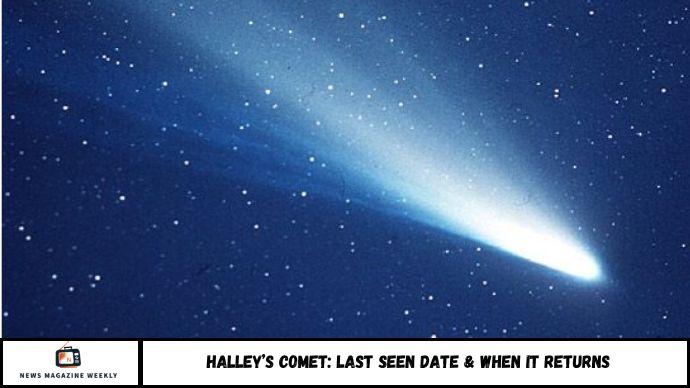Halley’s Comet, one of the most famous celestial objects visible from Earth, was last seen in 1986 and is expected to return in 2061. This article explores its historic sightings, orbital pattern, and when skywatchers can expect its next dazzling appearance. Backed by NASA data and astronomical insights, we answer the most common questions about this rare comet’s past, present, and future.
Halley’s Comet (officially 1P/Halley) is the most famous of all comet and for good reason. It’s a short-period comet, completing an orbit around the Sun roughly every 76 years, and it’s the only one of its kind regularly visible to the naked eye. Remarkably, it’s also the only short-period comet that can appear twice in a single human lifetime.
During its last visit in 1986, Halley’s Comet made history again—this time as the first comet ever studied up close by spacecraft, providing unprecedented scientific insights.
The comet is named after English astronomer Edmond Halley, who, in 1705, analyzed historical records of comet sightings from 1531, 1607, and 1682. He noticed that the comets shared a nearly identical orbital path and boldly predicted that the same comet would return in 1758. Although Halley passed away in 1742 and never witnessed the return himself, his prediction proved correct—securing his name in astronomical history.
Introduction:
“Look up and you might catch history in motion.”
That’s exactly what happened for millions in 1986, the last time Halley’s Comet passed near Earth. This cosmic wanderer has fascinated astronomers for centuries—and it’s the only short-period comet visible to the naked eye from Earth twice in one lifetime.
But when will it return again? And how do we know? In this article, we’ll break down:
- When Halley’s Comet was last seen
- Its historical significance
- When and where it will appear next
- Why its orbit makes it both predictable and special
What Is Halley’s Comet?
Halley’s Comet is a short-period comet that orbits the Sun approximately every 75–76 years. It’s named after Edmond Halley, the 17th-century astronomer who was the first to predict its return using Newton’s laws of motion.
Key Characteristics:
- Orbital Period: ~75–76 years
- Next Appearance: Mid-2061
- Speed: Up to 122,000 mph (196,000 km/h)
- Visibility: Naked eye (during close approaches)
When Was Halley’s Comet Last Seen?
Halley’s Comet was last visible from Earth in 1986. Despite heavy media coverage and global anticipation, visibility was limited due to its distant approach and unfavorable viewing conditions.
Quick Facts:
- Last Perihelion (closest to Sun): February 9, 1986
- Best Viewing Period: March–April 1986
- Orbit Distance at Closest Approach: 63 million km from Earth
- Notable Space Missions: Giotto (ESA) and Vega (USSR) spacecraft approached it
Will Halley’s Comet Return?
Yes, Halley’s Comet will return in 2061.
It will reach perihelion in late July 2061, and this time, it’s expected to pass much closer to Earth, potentially offering a spectacular view.
What to Expect:
- Better visibility than in 1986, especially in the Northern Hemisphere
- Could reach magnitude -1, brighter than most stars
- Likely visible to the naked eye in clear, dark skies
A Brief History of Halley’s Comet Sightings
Famous Appearances:
- 1066: Depicted in the Bayeux Tapestry, linked to the Norman conquest of England
- 1301: Inspired Giotto’s painting of the Star of Bethlehem
- 1910: Passed extremely close to Earth, with mass hysteria over toxic tail gases (which posed no real threat)
Scientific Milestone:
- Edmond Halley predicted its 1758 return, proving comets follow predictable, elliptical orbits
Why Does Halley’s Comet Keep Coming Back?
Unlike many comets that take thousands of years to orbit the Sun, Halley’s relatively short path brings it back roughly every 75 years. Its retrograde orbit—opposite the planets’ motion—also makes it unique and easier to study.
Scientific & Cultural Importance
- NASA and ESA missions studied its tail composition and core structure, advancing our understanding of cometary physics
- Its predictable return has made it a marker of generational astronomical events
- Often linked to folklore, art, and global mythologies, reinforcing its role in human history
FAQs
1. When was Halley’s Comet last seen?
It was last seen from Earth in 1986, though visibility was limited.
2. When will Halley’s Comet return next?
It is expected to return in 2061, with a much closer and brighter appearance.
3. Can you see Halley’s Comet without a telescope?
Yes, it is visible to the naked eye during favorable passes.
4. How often does Halley’s Comet appear?
Roughly every 75–76 years, making it a short-period comet.
5. Was Halley’s Comet ever close to Earth?
In 1910, it came within 22 million km, causing public panic at the time.
6. Is Halley’s Comet dangerous?
No. Its orbit is monitored, and it poses no known threat to Earth.
Conclusion
Halley’s Comet is more than just a celestial object—it’s a historic and cultural phenomenon that links past and future generations. From ancient tapestries to modern telescopes, it has captured human imagination for centuries.
With its next return in 2061, skywatchers will once again have a chance to witness this legendary comet streak across the sky. Mark your calendar now—it may be your once-in-a-lifetime show.

